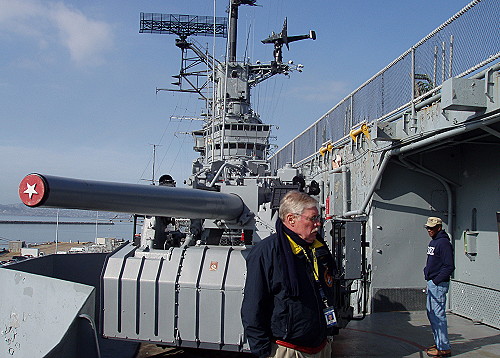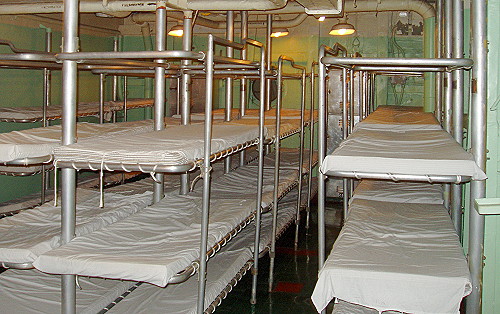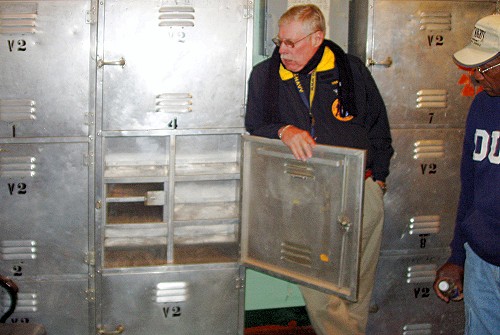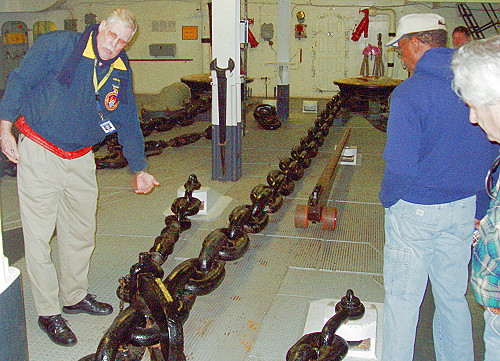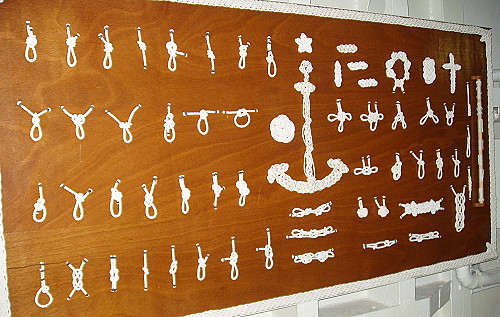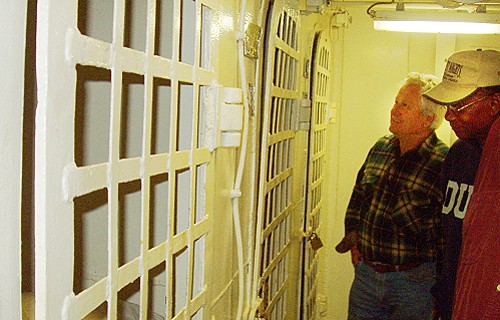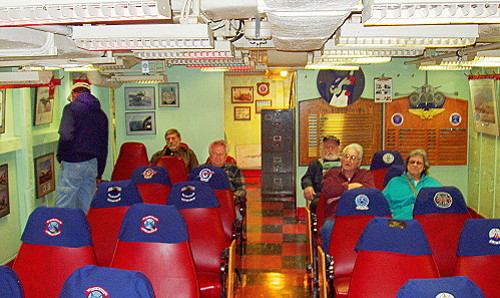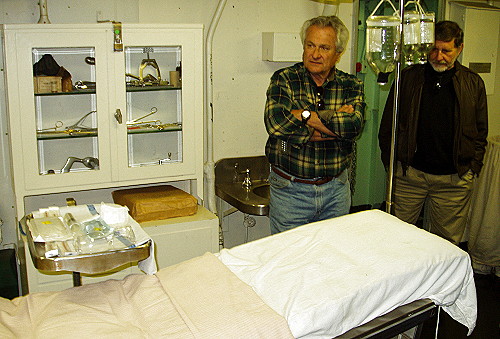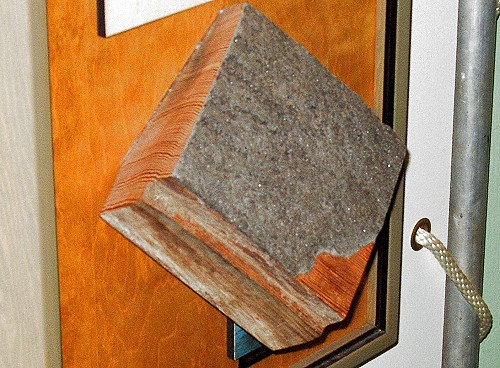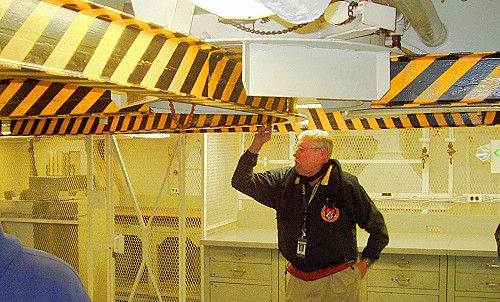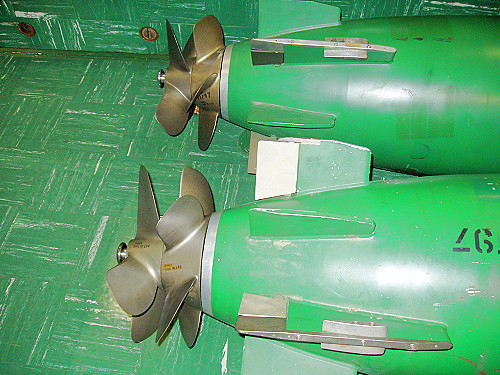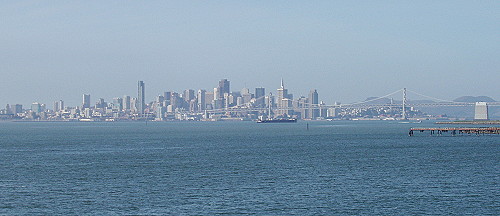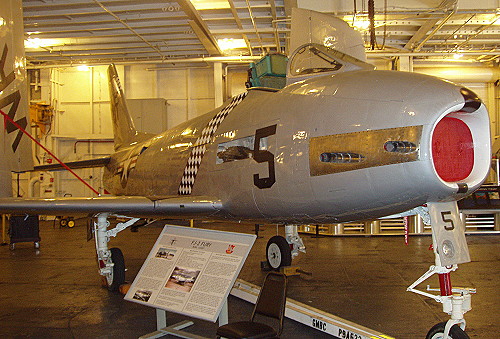 USS Hornet Aircraft Carrier Tour
A trip down memory lane — Alameda Point, CA —
|
|
|
||||||||||||||||||||
| We arrived just in time for the first tour which began with a short video about the history of the USS Hornet. Then a small group assembled for a tour of the hanger deck and the second deck. Our tour guide was Carl who would also take us on a third tour that took us into the bowels of the ship to the engine room. At the forward end of the hanger deck, Carl told us about a crossways catapult system. The story of how aircraft were launched from the hanger deck, through an opening in the side of the ship, sounded as if it must have been a terrifying experience. We were also told about the center elevator that would be one of several reasons the USS Hornet was retired from service. Our group was led out onto a weather deck where a five inch gun was located. We were told how rounds of ammunition for the the guns rose from below via a specialized elevator. After explaining how the gun was used we headed inside the ship. What we were going to see was very familiar to me. Carl took us through an enlisted men's berthing area with racks — that is "Navy speak" for bunks — stacked four high. Carl opened a typical locker in the area which would normally hold everything a sailor owned other than his pea coat. When I first joined the Navy I learned how to fill a locker and I was amazed at how much would fit in such a small storage compartment. The secret is how the clothes are folded that allows a full sea-bag to fit into a locker. Pea coats are bulky enough that separate lockers are provided just for pea coats. From the berthing area we went forward to a compartment where the anchor chains were secured — the biggest chains I've seen. Carl explained how the anchor system worked and gave us some statistics about the anchors and chains. There is a turnbuckle that is bigger than anything I've seen, so I took a photo of the turnbuckle with my foot next to it to show the scale. On the bulkhead, forward of the chains is a display board that has examples of the many knots used by seamen. We would find several displays similar to this in other places on the ship. This display, like many things on this tour, brought back memories when I had to learn to tie and untie most of the knots shown on the display board. As our group moved on to the next location on our tour, I looked down an open hatch where
I could see an open water-tight door that was in the upper engineering area. We ended up in
the junior officers berthing area which is quite different from the enlisted berthing areas. There was a space that had display cases that contained various models of aircraft and ships. We were told that this area was a ships store where the products for sale would have been displayed. This ship';s store was much bigger than the one on my ship. From the old ship's store we visited the brig. This was the first time for me to see a brig. It was just as the descriptions I'd heard from shipmates who had spent time there. Carl told us about the hard time spent by inmates and said that it was hard so men would do what was needed to not return. From the brig we followed our guide to one of the below deck catapult mechanisms. We were told that the Hornet used hydraulic catapults unlike the steam powered devices used on modern aircraft carriers. Apparently this was one of the reasons the USS Hornet was taken out of service. It seems it would have taken too much to convert to steam powered catapults. The cable and pulley system looked too bulky to be able to launch an airplane. I imagine the noise in this area must have been extreme during launches. Our next stop was the pilot's ready-room. I found it interesting that our whole tour group took seats in the back of the room. This reminded me of some company meetings I've attended, during my career, where there was a competition for the rear rows of seats so as to not to get "volunteered" for unpleasant tasks. 
Our tour guide was very knowledgeable about all aspects of the ship's operations. He told us what happened in the ready-room and why it was located where it is on the Hornet. The location is one deck lower on the Hornet than on current carriers. As a result, unlike today's carriers, the Hornet has an escalator for the pilots to get up to the flight deck. We would have an opportunity to use the escalator later. In the ready room is a colorful display of the shoulder patches that represented various air squadrons. Our next stop was a small laundry area where we saw a machine — a mangle — used to iron bed linen. I'm guessing that it had been more than fifty years since I last saw a mangle. This was seen on the way to a hospital area where we saw a small operating room that had an array of battery powered lanterns used to illuminate that operating area. Nearby was a convalescent area with racks stacked only two high. Moving on, I was getting used to ducking low objects and stepping over the raised openings of watertight doors. This had become second nature when I was in the Navy. It seemed as if areas on a ship are designed for people who are six feet tall or less. I'm a little taller than six feet, so I learned quickly to duck. Various objects and areas were pointed out as we moved on to another part of the ship. We
passed by a wall mounted display protruding from the bulkhead. Carl stopped for a few minutes
to explain that what we were looking at was a small piece of the wooden flight deck. It seems
that this particular aircraft carrier has a flight deck covered with wood that looks as if it
might be three or four inches thick with a relatively thin coating of non-skid material. Our tour group entered the torpedo shop where it was pointed out that there are some particularly low hanging rails. They were painted in a black and yellow pattern of slanted stripes. We were told that the paint job was to make the rails stand out so a person knew to duck lower than normal. The rails winded, serpentine like, around one compartment and into another. We were told that the steel rails were used to transport torpedoes from storage areas to where they could be used for combat operations. Shortly after being told about the torpedo rails we were shown the storage areas for a couple of different types of the so-called fish. The torpedoes were tucked into small compartments here-and-there directly below the overhead transport rails. After leaving the torpedoes we passed another galley and mess area as we proceeded to the fantail. This is one of several places on the ship where there is a million dollar view of San Francisco across the bay. I remember that this is the same view we had from my ship which was usually moored on the other side of the pier. I had to take a few photos of such a magnificent scene. At the pier on the other side of the slip from the Hornet was a cargo ship that was somewhat like the one I served on for a little more than three years. Looking down at the end of the carrier pier was a good example of a tug boat. It looked as if it might be in service rather than a museum display. From the fantail our group returned to the hanger deck at the opposite end from where we began the tour. We were shown an example of an airplane that was waiting to be restored. The aircraft was in pieces with a smashed engine with bent propeller still mounted. The front of the fuselage was missing and the wings were removed and lying next to the airplane body. Near the broken airplane was a display board that held examples of rounds of ammunition used in the guns on older fighter aircraft. Nearby was a more modern warplane that had more modern armament in the form of a couple of missiles mounted on hard-points under a wing.
Next we saw a jet fighter that was my favorite in the early 1950s — an F-86 Sabre. This was the workhorse of air-combat in the Korean War where the F-86 was more than a match for the Soviet MiG-15s. The aircraft was made by North American Aviation in their Southern California plant. It was fun for me to see this aircraft up close. Moving on we came to the Apollo 11 display and artifacts. The actual Mobile Quarantine Facility (MQF) in the form of a greatly-customized, Airstream travel-trailer. Next to the trailer is an Apollo command module that flew in space unmanned before to pave the way for manned missions that followed. This command module was pulled from the sea by the crew of the USS Hornet setting the stage when manned capsules would be retrieved. We were then told that this was the end of the tour and we now could explore on our own or take the top-side tour which is what we decided to do. |
|||||||||||||||||||
|
Page 1
Disclaimer
|
